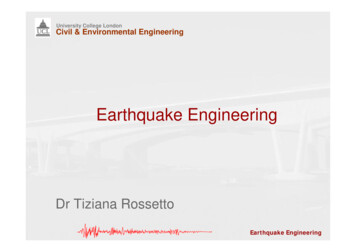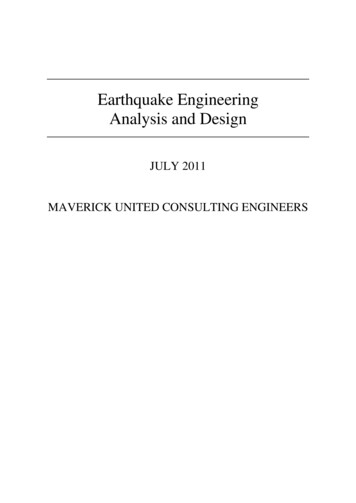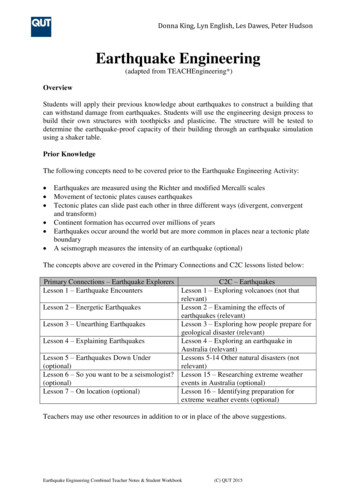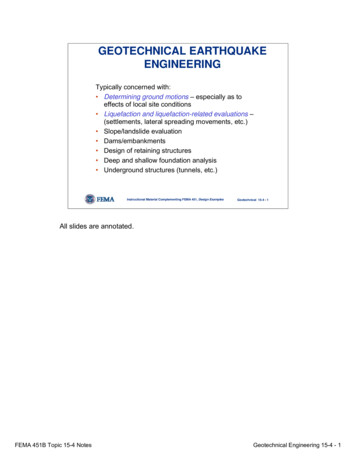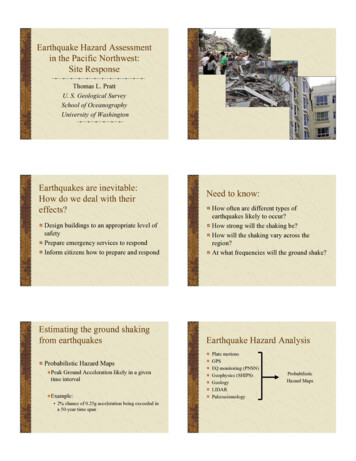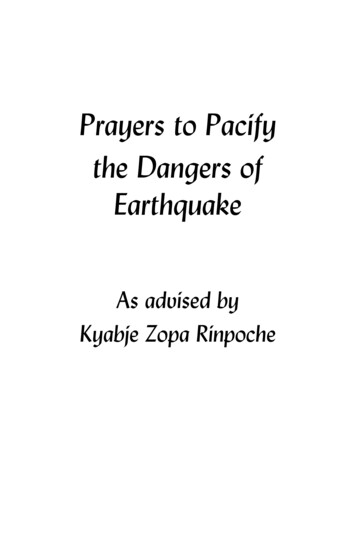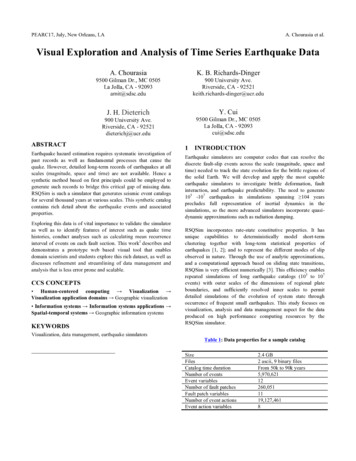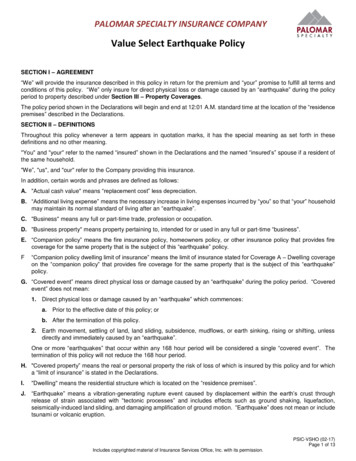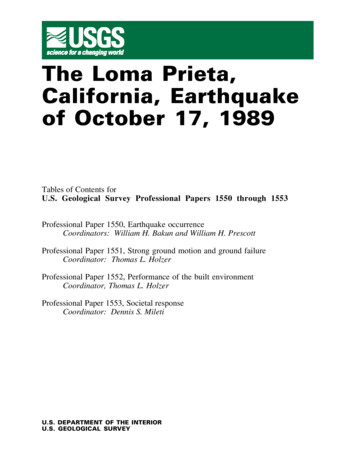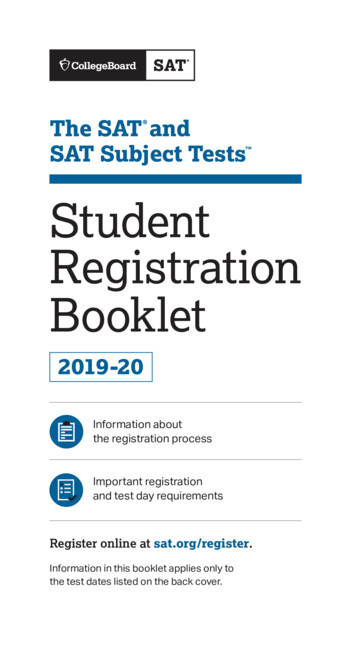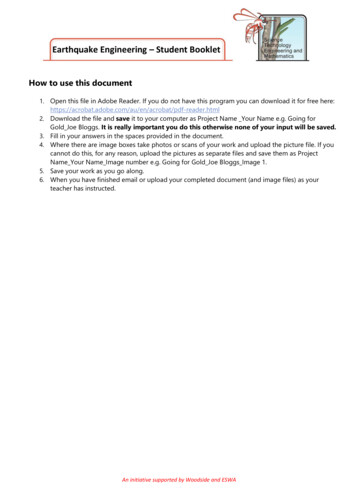
Transcription
Earthquake Engineering – Student BookletHow to use this document1. Open this file in Adobe Reader. If you do not have this program you can download it for free eader.html2. Download the file and save it to your computer as Project Name Your Name e.g. Going forGold Joe Bloggs. It is really important you do this otherwise none of your input will be saved.3. Fill in your answers in the spaces provided in the document.4. Where there are image boxes take photos or scans of your work and upload the picture file. If youcannot do this, for any reason, upload the pictures as separate files and save them as ProjectName Your Name Image number e.g. Going for Gold Joe Bloggs Image 1.5. Save your work as you go along.6. When you have finished email or upload your completed document (and image files) as yourteacher has instructed.An initiative supported by Woodside and ESWA
Earthquake Engineering – Student BookletThe ChallengeDesigning earthquake resistant buildings can be lifesaving, especially for people living neartectonic boundaries. Your job is to investigate the causes of earthquakes and their effectson different ground types and building designs. You should select a particular location thatyou think would benefit from better earthquake engineering and design a building thatwould be suitable for this location.Background InformationEarthquakes can be devastating, destroying structures and buildings and taking lives. In2017 there were 12,527 earthquakes recorded with a magnitude of 4 or higher globally. Thedeadliest of which was a 7.3 magnitude earthquake which occurred on November 12, killing630 people in Iran and 10 in Iraq. Interestingly, Russia and New Caledonia both experiencedearthquakes of similar depth and magnitude of that in Iran in 2017 and had no fatalities.Figure 1. Devastation caused by the Iran - Iraq Earthquake of 2017. (By Tasnim News Agency, 2017)An initiative supported by Woodside and ESWA
Earthquake Engineering – Student BookletEarthquakes are caused by fault movement.This can occur on a micro to mega scale. Mostearthquakes that cause damage are due tomovement of tectonic plates, however volcanicactivity, and crustal adjustments can also causeearthquakes. Earthquakes have also beenlinked to anthropogenic causes, such as frackingand mining.Figure 2. Diagram of the epicenter of an earthquake, wheremovement along a fault plane has caused it. (Hocevar, 2014)Damage caused by earthquakes can becatastrophic economically for families,businesses and whole countries. Withinfrastructure and buildings often having tobe completely rebuilt. The design ofbuildings is therefore of paramountimportance to avoid being damaged.Figure 3. Three story building on springs in North Carolina todampen earthquake waves. (Shustov, 1999)Due to the causes of earthquakes somecountries are much more likely toexperience them. This makes it easier forgovernments to decide if they shouldprioritise earthquake engineering toprotect their people. Unfortunately a lot ofthe current designs that do work well arevery costly, and unaffordable for many.An initiative supported by Woodside and ESWA
Earthquake Engineering – Student BookletBackground Research1. What causes earthquakes? Add labelled diagrams/pictures to aid your explanation. Insertthis below or attach as a separate file.Suggested site: nt/what-causes-earthquake2. Which type of earthquake waves cause most devastation to houses. How dothey move?Suggested site: mic-waves3. Where did the three most devastating earthquakes occur last year, in terms offatalities?LocationNumber of fatalitiesSuggested site: https://en.wikipedia.org/wiki/List of earthquakes in 20184. Where did the 5 strongest earthquakes occur last year?LocationMagnitudeSuggested site: https://en.wikipedia.org/wiki/List of earthquakes in 20An initiative supported by Woodside and ESWA
Earthquake Engineering – Student Booklet5. What are the top 3 most earthquake prone countries?Suggested site: ture/10-earthquake-prone-countries-in-theworld/6. What is the gross domestic product (GDP of those countries?CountryGDPSuggested site: https://en.wikipedia.org/wiki/List of countries by GDP (nominal)7. Describe and explain other hazards caused by earthquakes.HazardHow an earthquake can cause itDamage it can causeTsunamiLiquefactionFireLandslideSuggested site: https://earthquake.usgs.gov/learn/glossary/?term earthquake%20hazard8. What are the common causes of death/ injury by an earthquake?Suggested site:http://eqseis.geosc.psu.edu/ cammon/HTML/Classes/IntroQuakes/Notes/earthquake effects.htmlAn initiative supported by Woodside and ESWA
Earthquake Engineering – Student BookletWhere in the World?ObjectiveTo explore the relationship between earthquake location and tectonic plates through use ofGIS (Geographical Information Systems) and secondary data.There are two possible methods for this investigation.Option 1 – Using secondary data and paper mapsEquipment List of recent earthquakes with location, magnitude and depth data (can be accessedon Wikipedia or through Geoscience Australia).Map of the world with longitude and latitude lines on itSticky dots or different coloured pensMethod1. Locate the epicenter of the each of the earthquakes on the map using the latitudeand longitude coordinates. ( Latitude North, - latitude South. longitude East,- Longitude West)2. Place a sticky dot, or mark on the location with a pen.Option 2 – Using secondary data and Google mapsEquipment ComputerAccess to Google mapsAccess to the USGS site or WikipediaExcelMethod1. Create a spreadsheet in Excel with the following headings: Magnitude, Latitude,Longitude and Depth (km). Use information from Wikipedia, add details forearthquakes for the past year.Orgo to the USGS website and in the earthquake catalogue create a new searchrequest - https://earthquake.usgs.gov/earthquakes/search/ Select custom for the magnitude and set to 6 Select custom for date and time (1 year). Select World under Geographic location Under the Output tab select CSV fileAn initiative supported by Woodside and ESWA
Earthquake Engineering – Student BookletFigure 4. Screenshot showing what to select on the USGS Earthquake catalogue.2. Open Google maps and click on the menu tab. Then select “My Places.”Figure 5. Screen shot of google maps showing the menu bar.An initiative supported by Woodside and ESWA
Earthquake Engineering – Student Booklet3. Next select Maps - create map.Figure 6. Screenshot of Google maps, select MAPS on the top bar, then CREATE MAP at the bottom of the menu bar.4.Now you can either individually add each data point by selecting “add marker” tool(highlighted in yellow circle) OR you can import data directly from your spreadsheet byselecting “import”.Figure 7. Screenshot highlighting where to select if you wish to add individual data points manually, or where to select ifyou wish to import a whole CSV file.An initiative supported by Woodside and ESWA
Earthquake Engineering – Student BookletResults and Analysis1. Connect the data points, where you feel it is appropriate, either on yourpaper map or on Google maps using the drawing tool – attach a copy of thisto your work.2. Compare your outline to a map of tectonic plates of the world. What do younotice?3. Are there any countries that look particularly at risk of earthquakes, withnumerous plate boundaries passing through them? If so, which ones?4. Insert a screen shot of the map you created or attach as a separate file.An initiative supported by Woodside and ESWA
Earthquake Engineering – Student BookletEarthquake EnergyObjectiveTo be able to calculate the energy released by different magnitude earthquakes.BackgroundEarthquakes are generally reported by their magnitude, or more correctly – MomentMagnitude. This is a modified version of the Richter scale, which was devised in the 1930sby Charles Richter.You will have heard the magnitude of earthquakes being reported on the news, andprobably have a good understanding that the larger the earthquake the more energy – andtherefore the more destructive power it has. However, the earthquake magnitude is notmeasured on a linear scale, in fact for each unit of increase (1, 2, 3 ) the earthquake will be10 times bigger and release around 31.6 times more energy.Complete the table below to show how much bigger each earthquake is and how muchmore energy it releases. You may wish to use the USGS “How much bigger ” onlinecalculator to help.ResultsTimes bigger thanmagnitude 1Magnitude123456789110100Times stronger than amagnitude 1 (energyreleased)131.6100,000Extension: Re-write the table expressing the numbers in scientific notation.How much more energy does a magnitude 8 earthquake release compared to a magnitude4?An initiative supported by Woodside and ESWA
Earthquake Engineering – Student BookletCase StudiesObjectiveTo be able to explain the design features of buildings which have enabled them to withstandearthquakes.With increasing population size more and more people are living in seismically unstableareas and are at risk of being affected by earthquakes. Better building designs are muchmore in demand, and new ideas, to prevent building collapse, are being engineered.Research the following engineering ideas to explain the principles behind the design andhow it will help to reduce structural failure caused by earthquakes.Add any extra ideas to the table that you find during your research.ResultsPrincipleHow it worksExample of building usingthis design (give locationas well)SteelreinforcedconcreteSuggested site: concrete-structures-are-much -safer-in-earthquake-zones/Base isolationsystemsDiagonalbracingSuggested site: https://en.wikipedia.org/wiki/Base isolationSuggested site: https://sc thquake-resistant- buildings3.htmTuned massdamperSuggested site: -mass-dampers-in-skyscrapersSpringsSuggested site: https://sci hquake-resistant-bu ildings4.htmAn initiative supported by Woodside and ESWA
Earthquake Engineering – Student BookletPrincipleHow it worksExample of building usingthis design (give locationas well)EarthquakecurtainsSuggested site: nt-curtain-buildingFlexiblematerials (e.g.bamboo)Suggested site: https:/ tmlAnalysis1. Which, if any, of the designs have worked (withstood numerous earthquakes)?2. Which design ideas will be better for countries with a low gross domestic product?Explain your answer.3. Which design idea do you think will be utilised the most in the future? Explain youranswer.An initiative supported by Woodside and ESWA
Earthquake Engineering – Student BookletModelling LiquefactionObjectiveTo investigate the behaviour of different ground types when shaken, and relate that toengineering considerations for building in an earthquake prone zone.Equipment 1 x transparent storage box/large Tupperware boxSand and soilRocksWater2 x ping pong ballsModel house (you could make a small one from Lego orDuplo)Method1. If you have not already, research liquefaction in response to an earthquake. Use alabelled diagram to explain your answer. Attach this as a separate file.Suggested site: t1.html2. Pour enough sand into the box so that it is around 8 – 12 cm high.3. Bury the ping pong balls in the sand and place the house on top of the sand.4. Shake or tap on the side of the container for 30 seconds to simulate an earthquake.Make sure that you try to use the same force and speed throughout.5. Record your observations, take photos/videos if possible.6. Remove the house and ping pong balls and slowly add water to the sand to dampenit, there should be no water visible on the surface. Ensure the sand is evenly dampthroughout. Record how much water you added.7. Re –bury the ping pong balls and place the house back on top of the sand.8. Shake the container using the same speed and force as in step 4 to simulate anearthquake.9. Record your observations, take photos/videos if possible.10. Empty the container of sand and repeat the experiment using the substratessuggested in the results table.11. Record your observations for each test.An initiative supported by Woodside and ESWA
Earthquake Engineering – Student BookletResults and Analysis1. Record your results in the table below.SubstrateDry SandObservationsWet SandDry SoilWet SoilDry sand withrocks in itWet sand withrocks in it2. Which substrate was most affected by liquefaction?3. Which substrate was least affected by liquefaction?4. What happened to the ping pong balls when the “earthquake” hit, and why do youthink that happened? Use scientific understanding to aid your explanation.An initiative supported by Woodside and ESWA
Earthquake Engineering – Student Booklet5. Which substrate would you rather build your house on: granite, sandstone orunconsolidated sand/ silt? Use your data and observations as well as scientificknowledge and understanding to explain your decision.An initiative supported by Woodside and ESWA
Earthquake Engineering – Student BookletStrength of ShapesObjectiveTo investigate which shapes are strongest and also most likely to withstand applied forcesfrom different directions, to relate this to building design in an earthquake prone area.Equipment StrawsStringScissorsMethod1. Create the following shapes, endeavouring to make them similar in size: A square A rectangle An equilateral triangle A right angled triangle A circleThread the string through the straws and tie a knot at every corner, ensuring good ten
Earthquake Engineering – Student Booklet Earthquake Energy Objective To be able to calculate the energy released by different magnitude earthquakes. Background Earthquakes are generally reported by their magnitude, or more correctly – Moment Magnitude. This is a modified version of the Richter scale, which was devised in the 1930s
